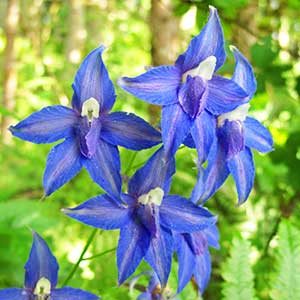Delphinium uliginosum
Delphinium trolliifolium
swamp larkspur
Columbian larkspur, cow-poison, poison delphinium, poison larkspur
10-30(-70) cm;
base reddish or not, nearly glabrous.
(40-)60-120(-180) cm;
base usually reddish, glabrous to puberulent.
blade obdeltoid, apically several parted, 1-8 × 1-7 cm, ± fleshy, glabrous; ultimate lobes 0-3, width 3-20 mm (cauline only);
margins of basal leaf, measured less than 1 cm from blade base, demarcating less than 90° of arc when leaf laid flat.
blade ± pentagonal, 4-8 × 7-16 cm, margins ± incised, nearly glabrous; ultimate lobes 0-9, width 15-30 mm (basal), 5-20 mm (cauline), widest at middle or in proximal 1/2.
5-20(-48)-flowered, ± open;
pedicel 0.3-3(-10) cm, glabrous to puberulent;
bracteoles 2-3(-5) mm from flowers, green to blue, lanceolate-linear, 3-4(-7) mm, puberulent.
(5-)14-40(-75)-flowered, ± open, at least 2 times longer than wide;
pedicel 1-4(-9) cm, puberulent to glabrous;
bracteoles (2-)6-12 mm from flowers, green, linear, 5-9(-14) mm, puberulent.
sepals dark blue, nearly glabrous, lateral sepals spreading, 9-15 × 5-8 mm, spurs usually upcurved, ascending 30-45° above horizontal, 10-14 mm;
lower petal blades slightly elevated, ± exposing stamens, 4-5 mm, clefts 2-3 mm;
hairs centered, densest on inner lobe above base of cleft, also on margins, white.
sepals dark blue, glabrous, lateral sepals spreading, (8-)14-21 × 5-9 mm, spurs straight or downcurved at apex, within 20° of horizontal, (10-)16-23 mm;
lower petal blades covering stamens, 5-10 mm, clefts 1.5-3 mm;
hairs sparse, mostly near junction of blade and claw, centered or on inner lobes, well dispersed, yellow.
10-18 mm, 4.1-4.5 times longer than wide, puberulent.
(15-)23-34 mm, 3.8-5.5 times longer than wide, glabrous.
seed coat cells with surfaces bumpy or wavy.
unwinged;
seed coats smooth.
= 16.
= 16.
Delphinium uliginosum
Delphinium trolliifolium
Although some populations are large, Delphinium uliginosum is very local. Hybrids with D. hesperium subsp. pallescens have been seen.
Delphinium uliginosum is a very distinctive species, not likely to be confused with any other. The fan-shaped, slightly dissected leaves are apparently unique in the genus.
(Discussion copyrighted by Flora of North America; reprinted with permission.)
Delphinium trolliifolium occurs in the northern Coast Range of California, the Columbia River Valley to just east of Mt. Hood, and the Willamette Valley of Oregon upstream to Lane County. California plants differ somewhat from Oregon plants in pubescence patterns and habitat preferences. Further study may show that two entities are involved here.
Hybrids between Delphinium trolliifolium and D. decorum, D. menziesii subsp. pallidum (D. ×pavonaceum Ewan, Peacock larkspur), D. nudicaule, D. nuttallianum, and D. nuttallii are known. Delphinium trolliifolium is likely to be confused only with D. bakeri. Refer to discussion under that species for differences.
(Discussion copyrighted by Flora of North America; reprinted with permission.)
